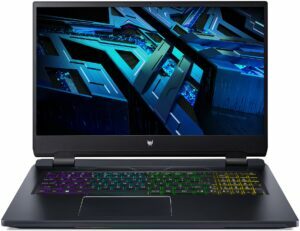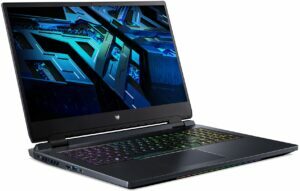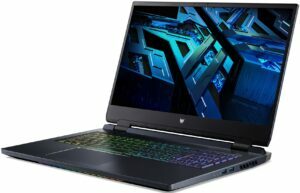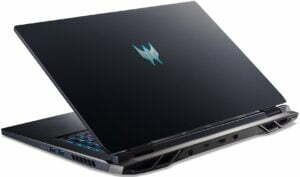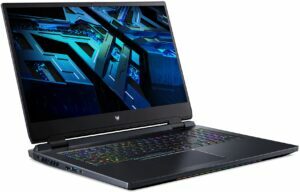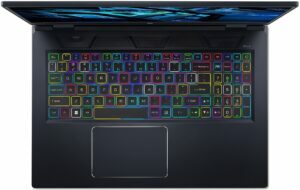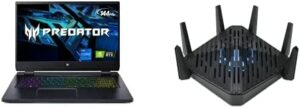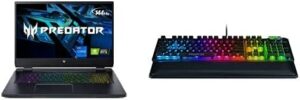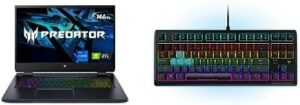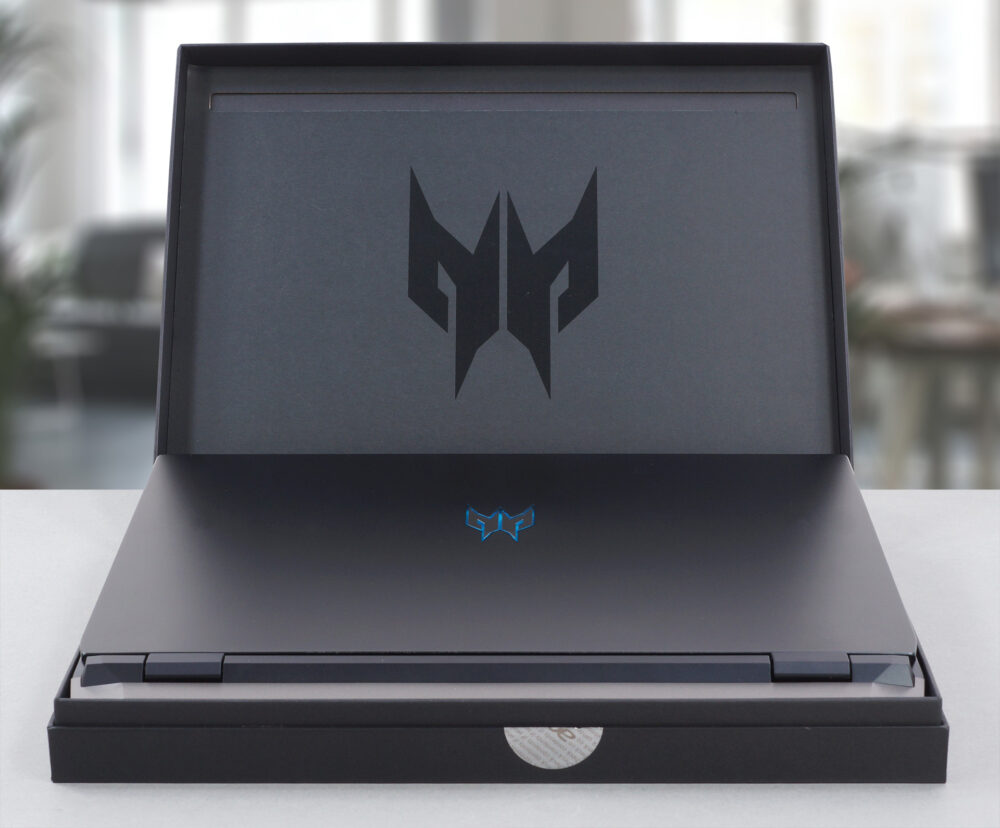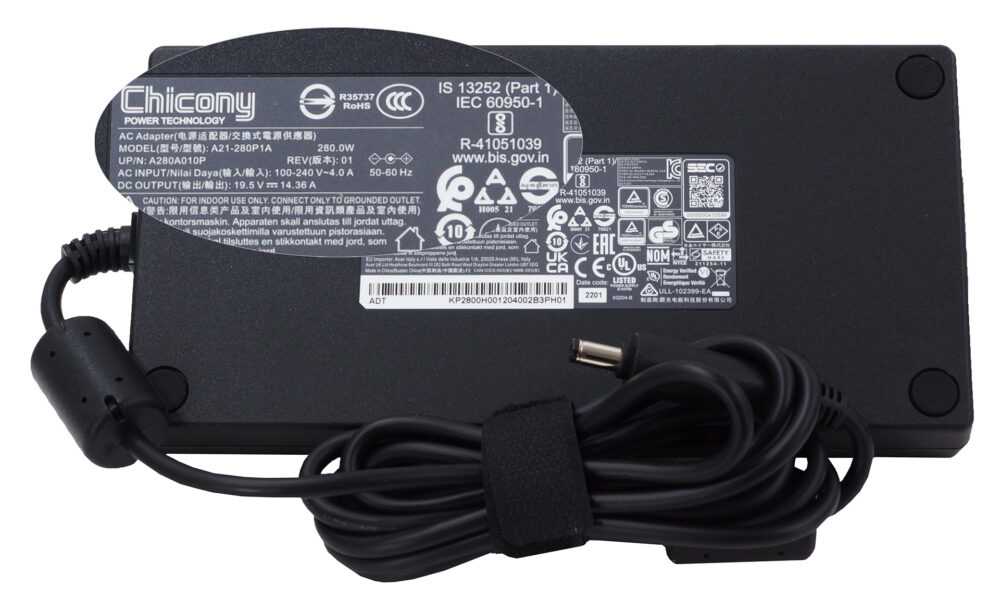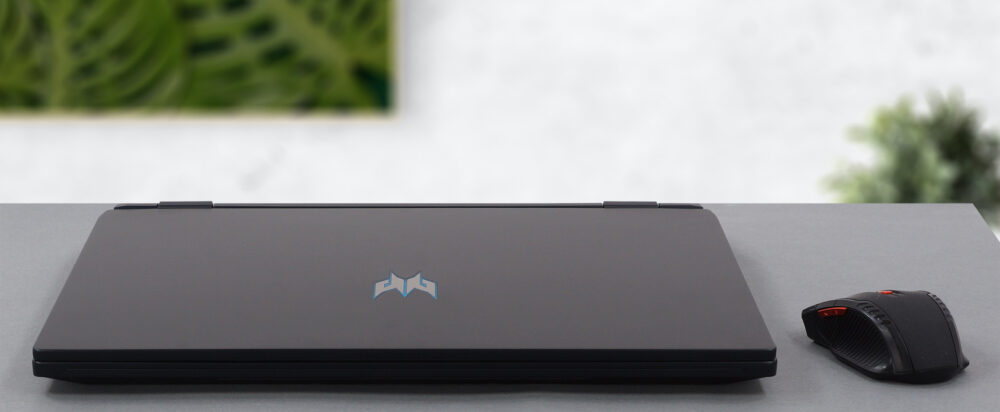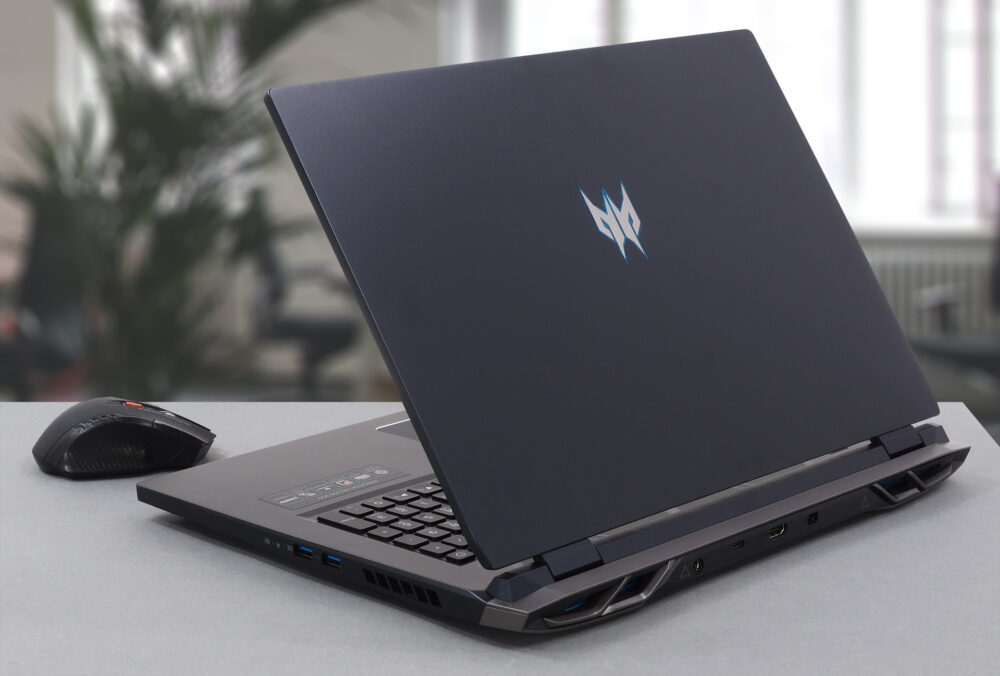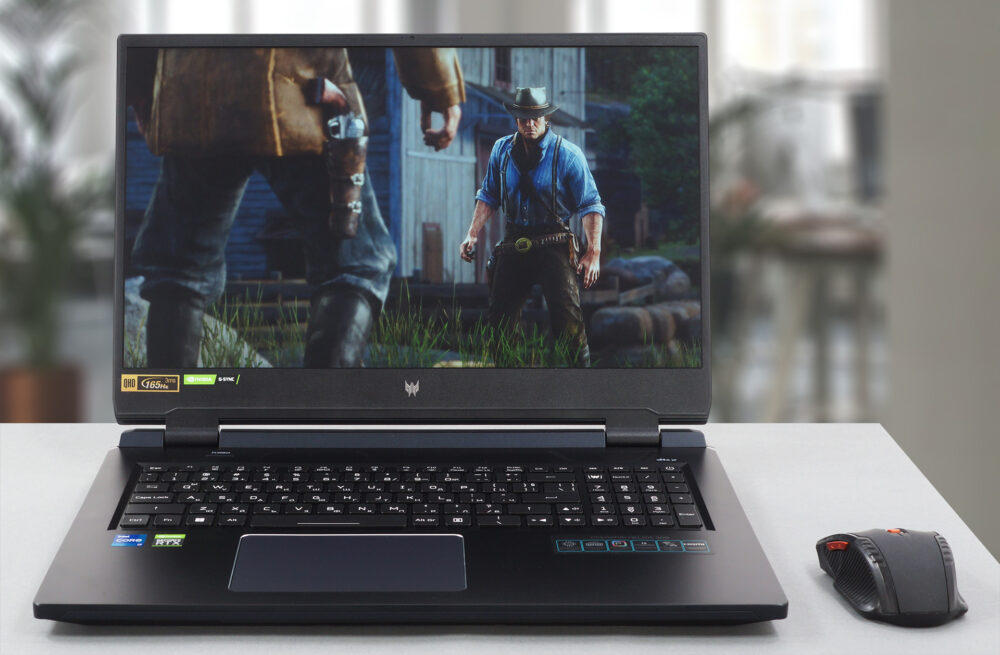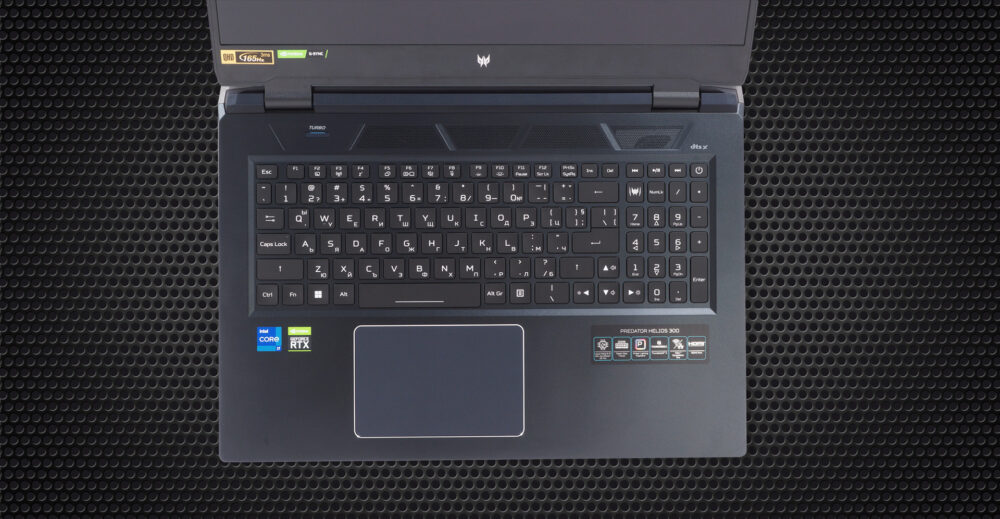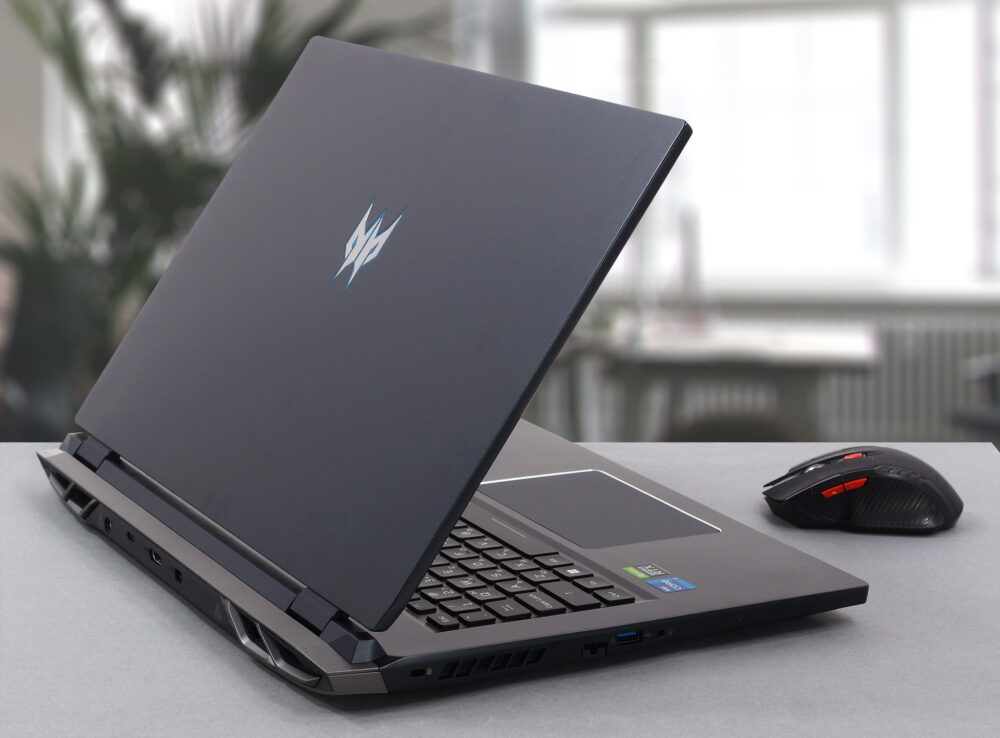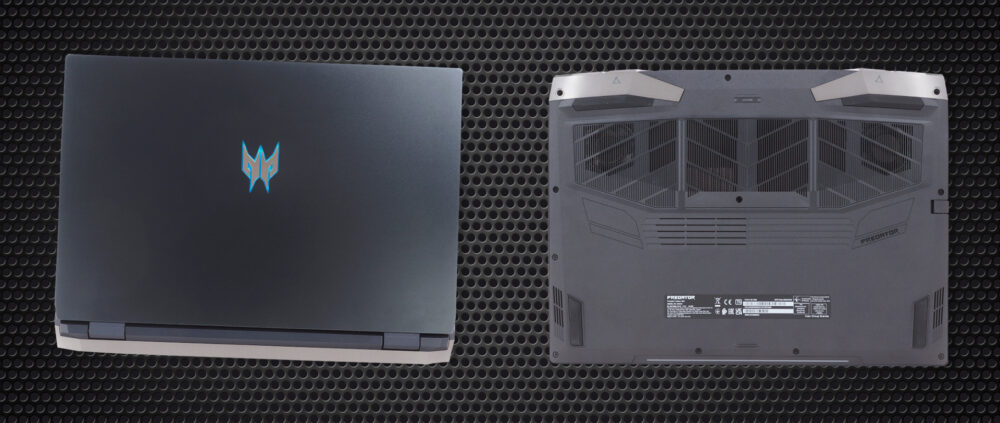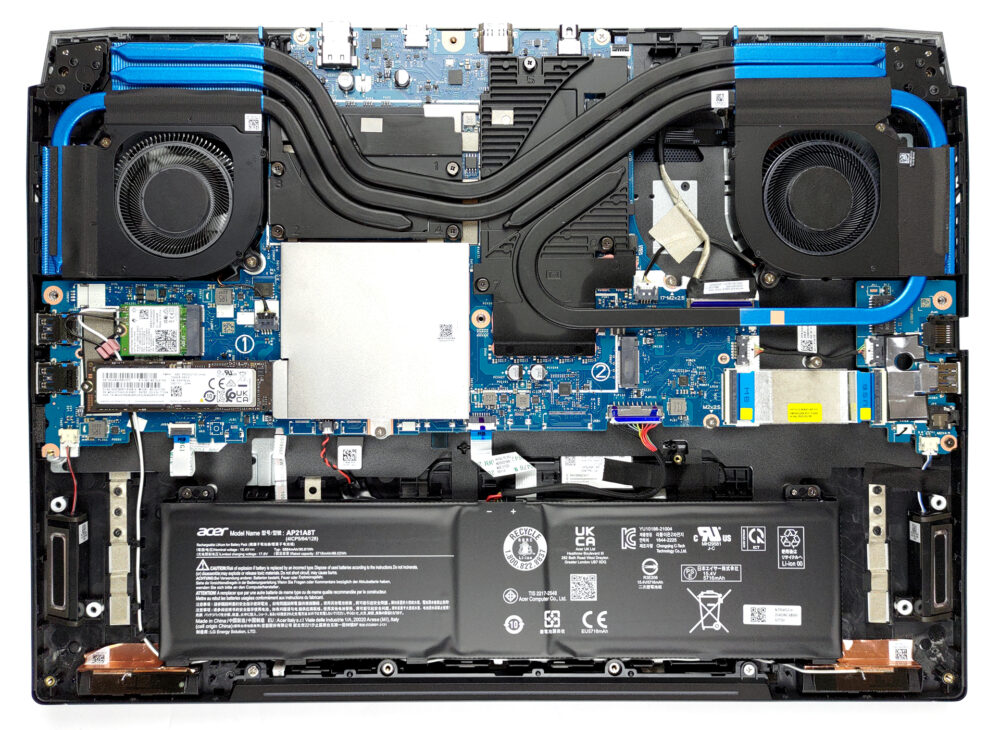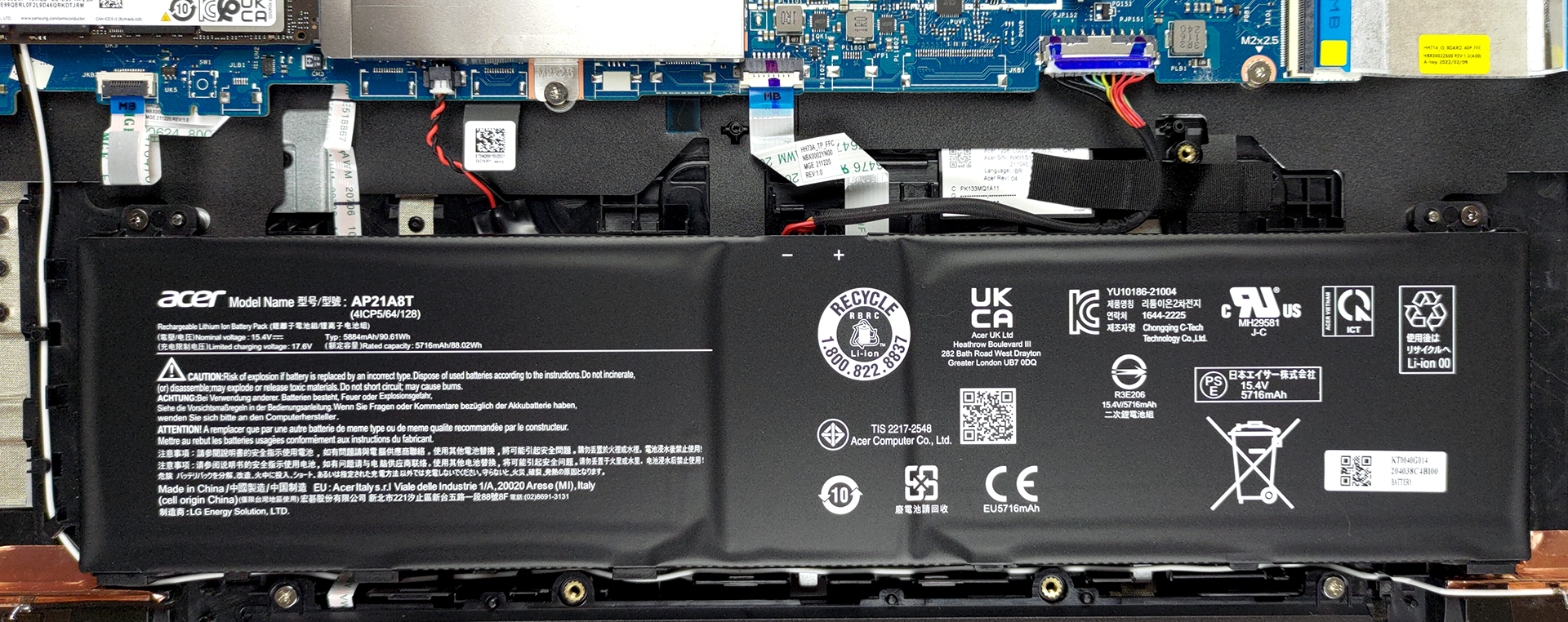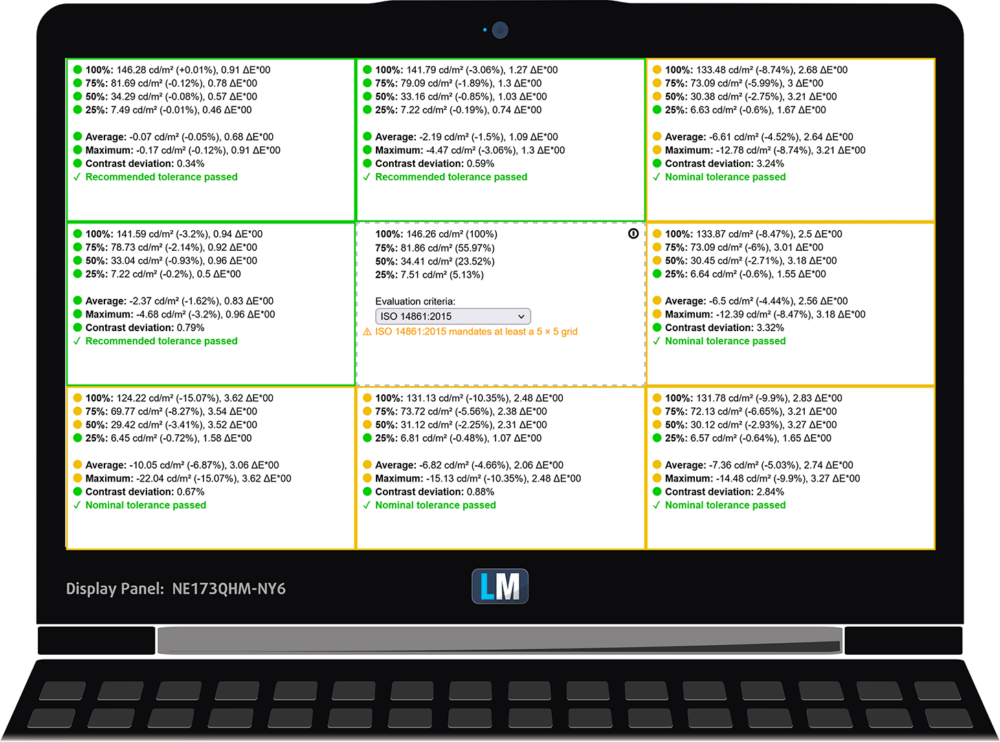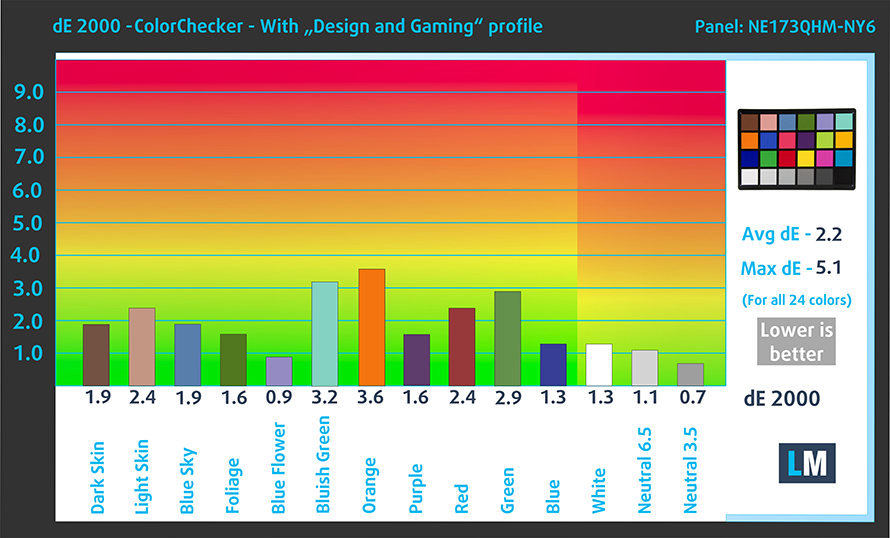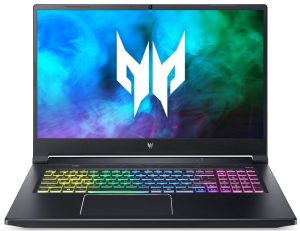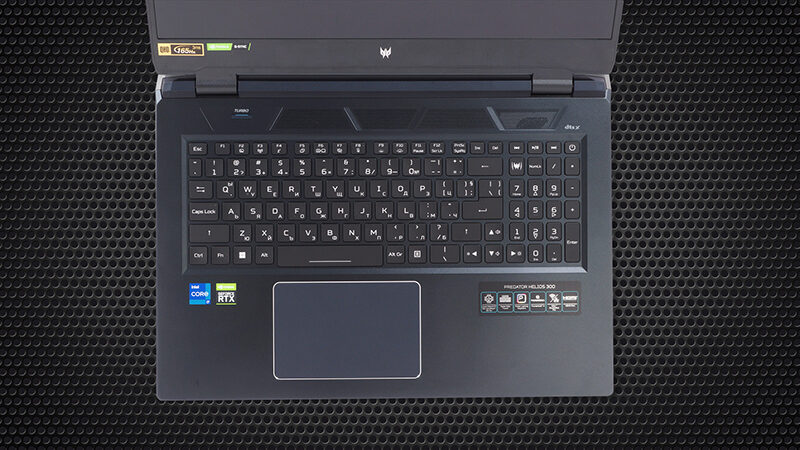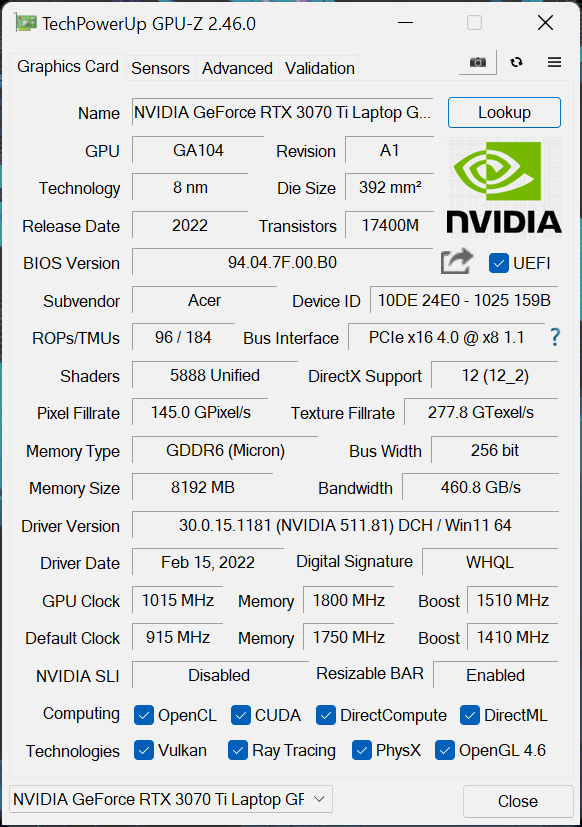Acer Predator Helios 300 (PH317-56) review
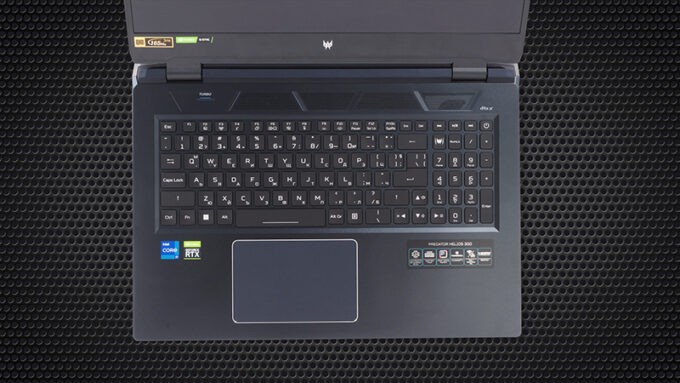 NVIDIA’s RTX 3000 graphics card lineup was once again a game-changer in the laptop world. As the company ditched the “Max-Q” design, manufacturers all over the place were opting for different TGP values. Acer for instance, was quite conservative in its approach, especially with its Nitro series.
NVIDIA’s RTX 3000 graphics card lineup was once again a game-changer in the laptop world. As the company ditched the “Max-Q” design, manufacturers all over the place were opting for different TGP values. Acer for instance, was quite conservative in its approach, especially with its Nitro series.
On the other hand, the Helios 300 was equipped with a 140W RTX 3070. Now, the brand has made a jump to the RTX 3080, while our unit came with a 150W RTX 3070 Ti. This, together with the Alder Lake CPU inside should make a difference. We are really hopeful for this year’s unit since the last one had some issues, which led to unimpressive clock speeds.
Yes, the reason for this was improper cooling. However, Acer has finally implemented a liquid metal thermal compound on the CPU. We expect it to make a huge difference not only in computational performance but also when it comes to gaming.
The display options are also pretty impressive, with a 1440p IPS panel available with a 165Hz refresh rate, and support of NVIDIA’s G-Sync and Advanced Optimus.
You can check the prices and configurations in our Specs System: https://laptopmedia.com/series/acer-predator-helios-300-ph317-56/
Contents
Specs Sheet
- HDD/SSD
- up to 1000GB SSD
- M.2 Slot
- 2x 2280 PCIe NVMe 4.0 x4 See photo
- RAM
- up to 32GB
- OS
- Windows 10 Pro, Windows 11 Home, Windows 10 Home, Windows 11 Pro
- Battery
- 90Wh, 4-cell
- Body material
- Plastic / Polycarbonate, Aluminum
- Dimensions
- 399.3 x 295.5 x 26.9 mm (15.72" x 11.63" x 1.06")
- Weight
- 3.00 kg (6.6 lbs)
- Ports and connectivity
- 1x USB Type-A
- 3.2 Gen 1 (5 Gbps)
- 2x USB Type-A
- 3.2 Gen 2 (10 Gbps)
- 1x USB Type-C
- 3.2 Gen 2 (10 Gbps)
- HDMI
- Displayport mini
- Card reader
- Ethernet LAN
- 10, 100, 1000 Mbit/s
- Wi-Fi
- 802.11ax
- Bluetooth
- 5.2
- Audio jack
- 3.5mm Combo Jack
- Features
- Fingerprint reader
- Web camera
- HD
- Backlit keyboard
- optional
- Microphone
- Speakers
- Speakers by DTS X: Ultra Audio
- Optical drive
- Security Lock slot
- Kensington Lock
All Acer Predator Helios 300 (PH317-56) configurations
What’s in the box?
Inside the package, we found the standard paperwork, as well as a 280W power adapter. It can also be used as a cutting board.
Design and construction
Well, it has finally happened! There is a minor redesign on a Helios. The change is more than welcomed by everyone here at the office (and we suppose you’re going to like it as well). The hinges now sit on a pedestal and make for a complete separation of the lid and base.
It’s worth noting that the laptop is made out of metal, and has great structural integrity with almost zero flex when twisted. Ultimately, it is a bit thick (26.9mm), and a bit heavy (3 kilos), but it’s definitely nothing, considering what it offers.
Unsurprisingly, the lid opens easily with a single hand. This action reveals thin top and side bezels, with a quite pronounced chin, home only to the Predator logo. Speaking of which, the logo on the back of the lid is illuminated. And above the matte display, you’re going to find an HD Web camera.
Now, let’s take a quick look at the base. There, we see a very clean design with a keyboard that features large Arrow keys, and a NumPad. It is good for typing and gaming. Plus, it comes with a Predator Sense shortcut button. Speaking of shortcuts, there is the dedicated “Turbo” button, that maxes out the fans. Above the keyboard, you will see a vent, which reveals parts of the cooling system.
And below it, there is a big touchpad with a glass surface and a shiny chamfered trim. The unit itself is great. However, it is not as good as the one on the ASUS TUF Dash F15 FX517.
If you turn the laptop upside down, you will find that the speaker cutouts are placed right next to the front feet of the device. A large portion of the bottom panel is taken by the ventilation grills, where the fans draw part of the cool air (the other part comes through the keyboard). Respectively, the heat is exhausted through four vents – two on the back and one on each side.
Ports
On the left side, you can see a Kensington lock slot, a LAN port, a USB Type-A 3.2 (Gen. 1) port, and an audio jack. Then, on the right, there are two USB Type-A 3.2 (Gen. 2) ports, while the back houses the power plug, a Thunderbolt 4 port, an HDMI connector, and a Mini DisplayPort.
Disassembly, upgrade options, and maintenance
Here, you’ve got to undo 11 Phillips-head screws. After that, pry the bottom panel starting from the front. Then, lift the panel away from the chassis.
The battery inside has a capacity of 90.6Wh. It lasts for about 7 hours of either Web browsing or video playback. Furthermore, it is pretty easy to remove. Just unplug the connector, and undo two Phillips-head screws.
To access the memory, you have to take out the metal bracket. It is held in place by one Phillips-head screw and a couple of clips. Once you remove it, you will have access to two RAM SODIMM slots, which work with DDR5 modules. As for the storage, you get two M.2 PCIe x4 slots, both of which can fit Gen 4 drives.
In terms of cooling, you get two heat pipes shared between the CPU and the GPU. The processor gets one more, while the GPU is treated to two additional heat pipes. Moreover, the graphics memory and the VRMs have a metal heat spreader, while two fans blow the heat away from the machine.
Display quality
Acer Predator Helios 300 (PH317-56) is equipped with a Quad HD 165Hz IPS panel, model number BOE NE173QHM-NY6 (BOE0A1A). Its diagonal is 17.3″ (43.94 cm), and the resolution is 2560 x 1440 pixels. The screen ratio is 16:9, and we are looking at a pixel density of – 170 ppi, and a pitch of 0.15 х 0.15 mm. The screen turns into Retina when viewed at distance equal to or greater than 51m (20″) (from this distance one’s eye stops differentiating the separate pixels, and it is normal for looking at a laptop).
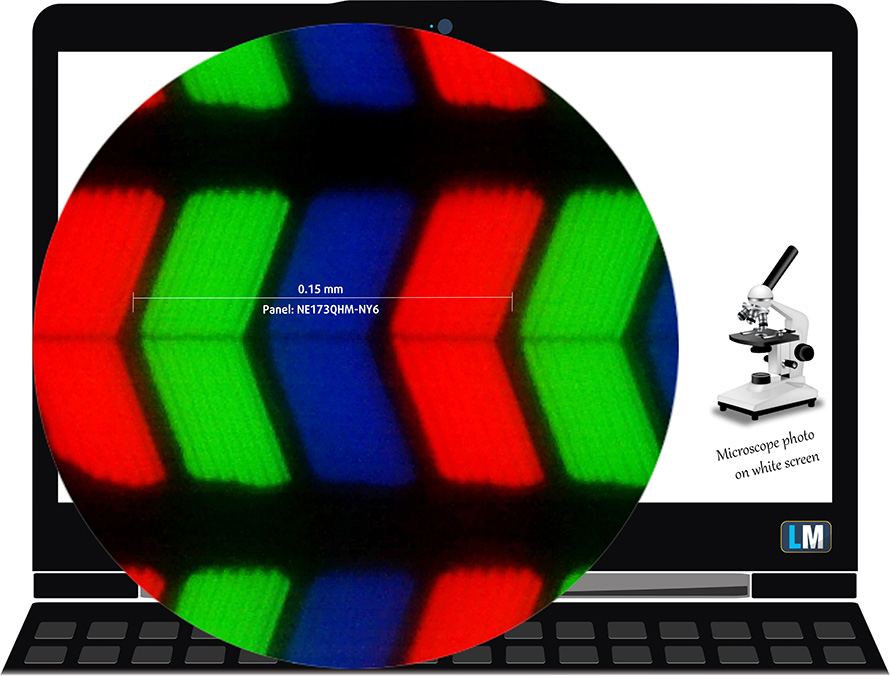
Viewing angles are comfortable. We offer images at 45° to evaluate image quality.

Also, a video with locked focus and exposure.
The measured maximum brightness of 374 nits in the middle of the screen and 347 nits as an average for the whole area, with a maximum deviation of 15%. The Correlated Color Temperature on a white screen is 7440K – colder than the optimal for the sRGB standard of 6500K.
In the illustration below you can see how the display performs from a uniformity perspective. In other words, the leakage of light from the light source.
Values of dE2000 over 4.0 should not occur, and this parameter is one of the first you should check if you intend to use the laptop for color-sensitive work. The contrast ratio is good – 1110:1.
To make sure we are on the same page, we would like to give you a little introduction to the sRGB color gamut and the Adobe RGB. To start, there’s the CIE 1976 Uniform Chromaticity Diagram that represents the visible specter of colors by the human eye, giving you a better perception of the color gamut coverage and the color accuracy.
Inside the black triangle, you will see the standard color gamut (sRGB) that is being used by millions of people on HDTV and on the web. As for the Adobe RGB, this is used in professional cameras, monitors, etc for printing. Colors inside the black triangle are used by everyone and this is the essential part of the color quality and color accuracy of a mainstream notebook.
Still, we’ve included other color spaces like the famous DCI-P3 standard used by movie studios, as well as the digital UHD Rec.2020 standard. Rec.2020, however, is still a thing of the future and it’s difficult for today’s displays to cover that well. We’ve also included the so-called Michael Pointer gamut, or Pointer’s gamut, which represents the colors that naturally occur around us every day.
The yellow dotted line shows Acer Predator Helios 300 (PH317-56)’s color gamut coverage.
Its display covers not only 100% of the sRGB/ITU-R BT.709 (web/HDTV standard) in CIE1976, but also 99% of the DCI-P3 color gamut. This leads to a very attractive and vibrant image.
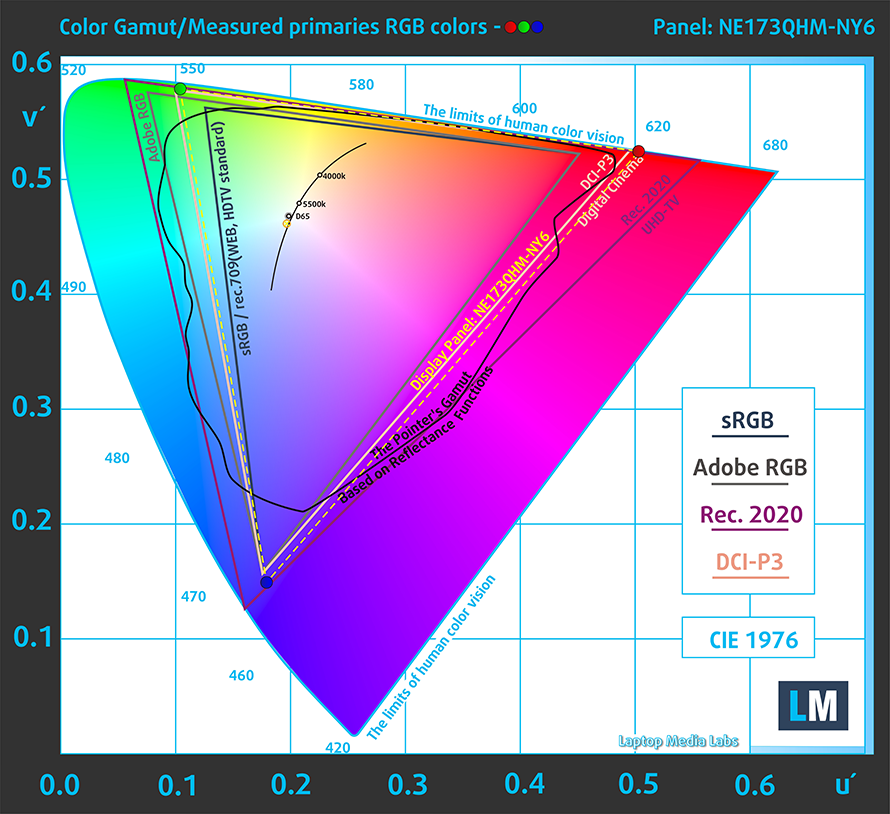
Our “Design and Gaming” profile delivers optimal color temperature (6500K) at 140 cd/m2 luminance and sRGB gamma mode.
We tested the accuracy of the display with 24 commonly used colors like light and dark human skin, blue sky, green grass, orange, etc. You can check out the results in factory condition and also, with the “Design and Gaming” profile.
Below you see the scores of Acer Predator Helios 300 (PH317-56) with the “Gaming and Web design” profile.
The next figure shows how well the display is able to reproduce really dark parts of an image, which is essential when watching movies or playing games in low ambient light.
The left side of the image represents the display with stock settings, while the right one is with the “Gaming and Web Design” profile activated. On the horizontal axis, you will find the grayscale, and on the vertical axis – the luminance of the display. On the two graphs below you can easily check for yourself how your display handles the darkest nuances but keep in mind that this also depends on the settings of your current display, the calibration, the viewing angle, and the surrounding light conditions.

Response time (Gaming capabilities)
We test the reaction time of the pixels with the usual “black-to-white” and “white-to-black” method from 10% to 90% and vice versa.
We recorded Fall Time + Rise Time = 9 ms.
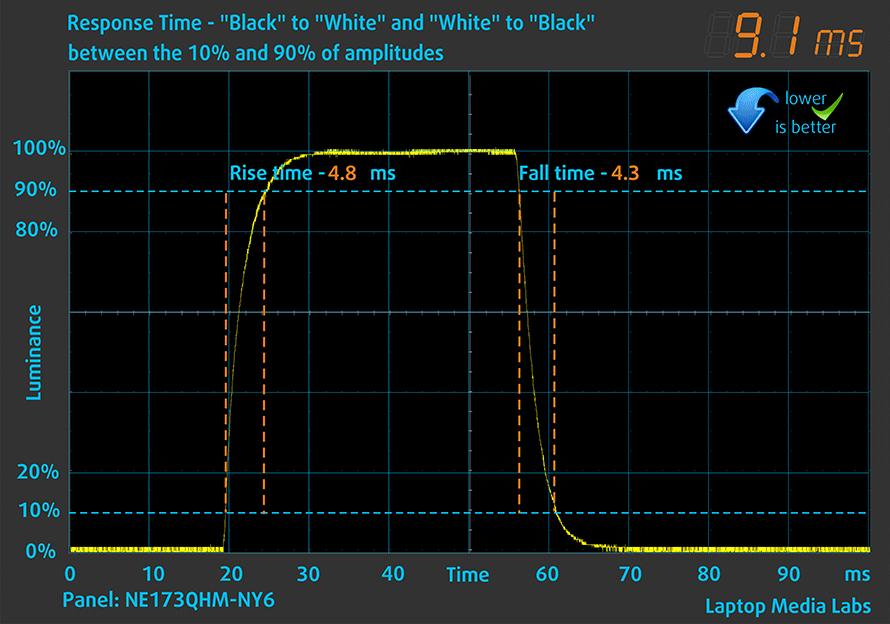
After that, we test the reaction time of the pixels with the usual “Gray-to-Gray” method from 50% White to 80% White and vice versa between 10% and 90% of the amplitude.
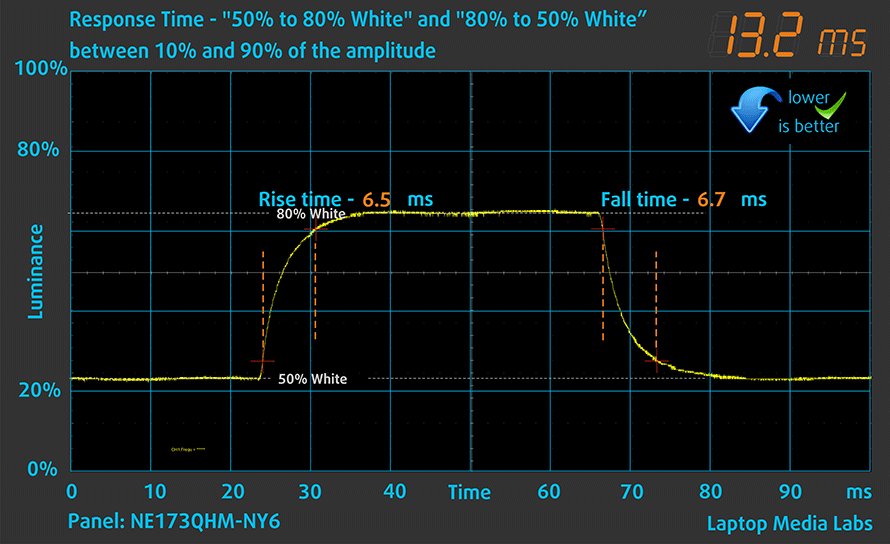
PWM (Screen flickering)
Pulse-width modulation (PWM) is an easy way to control monitor brightness. When you lower the brightness, the light intensity of the backlight is not lowered, but instead turned off and on by the electronics with a frequency indistinguishable to the human eye. In these light impulses, the light/no-light time ratio varies, while brightness remains unchanged, which is harmful to your eyes. You can read more about that in our dedicated article on PWM.
The backlight of the Acer Predator Helios 300 (PH317-56) doesn’t use PWM to adjust its levels of brightness. This means the display is comfortable for use, without presenting any excessive eye strain in this aspect.
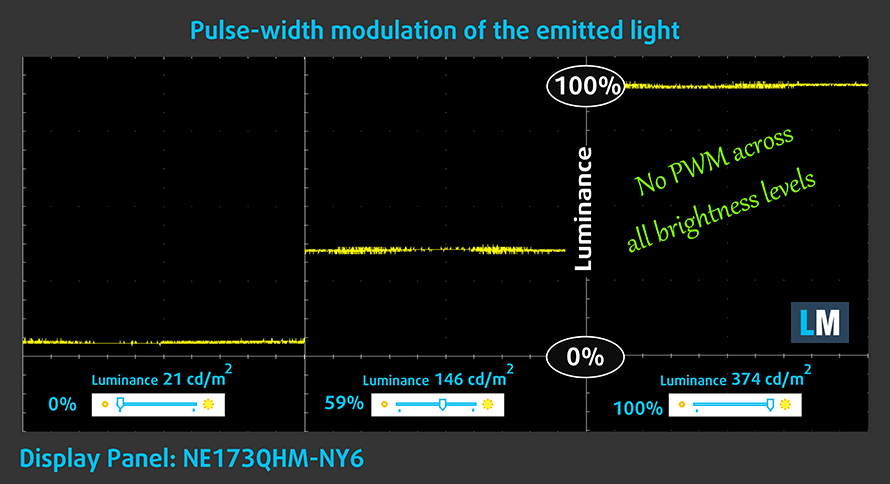
Blue light emissions
Installing our Health-Guard profile not only eliminates PWM but also reduces the harmful Blue Light emissions while keeping the colors of the screen perceptually accurate. If you’re not familiar with the Blue light, the TL;DR version is – emissions that negatively affect your eyes, skin, and your whole body. You can find more information about that in our dedicated article on Blue Light.
Buy our profiles
Since our profiles are tailored for each individual display model, this article and its respective profile package are meant for Acer Predator Helios 300 (PH317-56) configurations with 17.3″ Quad HD IPS BOE NE173QHM-NY6 (BOE0A1A).
*Should you have problems with downloading the purchased file, try using a different browser to open the link you’ll receive via e-mail. If the download target is a .php file instead of an archive, change the file extension to .zip or contact us at [email protected].
Read more about the profiles HERE.
In addition to receiving efficient and health-friendly profiles, by buying LaptopMedia's products you also support the development of our labs, where we test devices in order to produce the most objective reviews possible.

Office Work
Office Work should be used mostly by users who spend most of the time looking at pieces of text, tables or just surfing. This profile aims to deliver better distinctness and clarity by keeping a flat gamma curve (2.20), native color temperature and perceptually accurate colors.

Design and Gaming
This profile is aimed at designers who work with colors professionally, and for games and movies as well. Design and Gaming takes display panels to their limits, making them as accurate as possible in the sRGB IEC61966-2-1 standard for Web and HDTV, at white point D65.

Health-Guard
Health-Guard eliminates the harmful Pulse-Width Modulation (PWM) and reduces the negative Blue Light which affects our eyes and body. Since it’s custom tailored for every panel, it manages to keep the colors perceptually accurate. Health-Guard simulates paper so the pressure on the eyes is greatly reduced.
Get all 3 profiles with 33% discount
Sound
Acer Predator Helios 300 (PH317-56)’s speakers produce a sound of very good quality. Its low, mid, and high tones are clear of deviations.
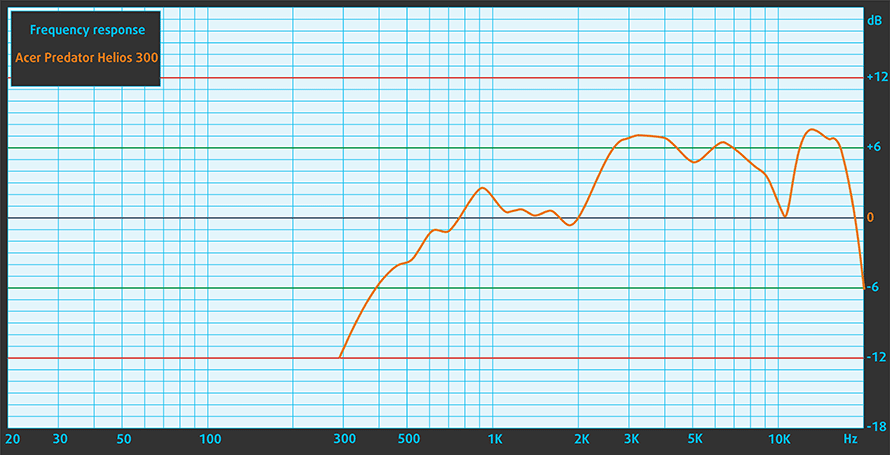
Drivers
All drivers and utilities for this notebook can be found here: https://www.acer.com/ac/en/US/content/support-product/9280?b=1
Battery
Now, we conduct the battery tests with the Windows Better performance setting turned on, screen brightness adjusted to 120 nits, and all other programs turned off except for the one we are testing the notebook with. Here, the 90.6Wh battery pack lasts for 7 hours and 5 minutes of Web browsing, or 6 hours and 48 minutes of video playback.
In order to simulate real-life conditions, we used our own script for automatic web browsing through over 70 websites.
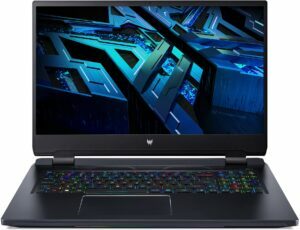
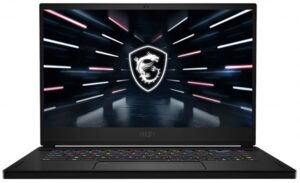
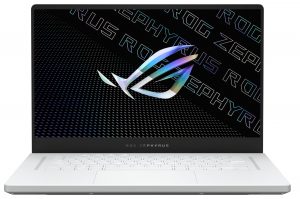
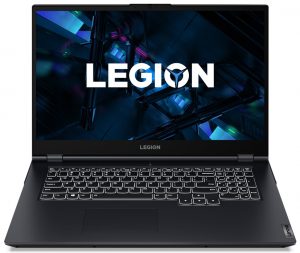

For every test like this, we use the same video in HD.





CPU options
Currently, we were able to find this device with the Core i7-12700H. It is an Alder Lake processor, that comes with 6 P-cores and 8 E-cores. The former comes with hyperthreading, which results in 20 threads being supported at once.
Results are from the Cinebench 20 CPU test (the higher the score, the better)
Results are from our Photoshop benchmark test (the lower the score, the better)
GPU options
Graphics-wise, there are the RTX 3060 (140W), RTX 3070, RTX 3070 Ti (150W), and RTX 3080.
Results are from the 3DMark: Time Spy (Graphics) benchmark (higher the score, the better)
Results are from the 3DMark: Fire Strike (Graphics) benchmark (higher the score, the better)
Results are from the 3DMark: Wild Life benchmark (higher the score, the better)
Results are from the Unigine Superposition benchmark (higher the score, the better)
Gaming tests
| Metro Exodus | Full HD, Low (Check settings) | Full HD, High (Check settings) | Full HD, Extreme (Check settings) |
|---|---|---|---|
| Average FPS | 163 fps | 97 fps | 49 fps |
| Borderlands 3 | Full HD, Medium (Check settings) | Full HD, High (Check settings) | Full HD, Badass (Check settings) |
|---|---|---|---|
| Average fps | 138 fps | 116 fps | 97 fps |

| Tom Clancy’s Ghost Recon Wildlands | Full HD, High (Check settings) | Full HD, Very High (Check settings) | Full HD, Ultra (Check settings) |
|---|---|---|---|
| Average | 141 fps | 124 fps | 83 fps |

| Shadow of the Tomb Raider (2018) | Full HD, Medium (Check settings) | Full HD, High (Check settings) | Full HD, Highest (Check settings) |
|---|---|---|---|
| Average | 149 fps | 145 fps | 107 fps |
Temperatures and comfort
Max CPU load
In this test we use 100% on the CPU cores, monitoring their frequencies and chip temperature. The first column shows a computer’s reaction to a short load (2-10 seconds), the second column simulates a serious task (between 15 and 30 seconds), and the third column is a good indicator of how good the laptop is for long loads such as video rendering.
Average core frequency (base frequency + X); CPU temp.
| Intel Core i7-12700H (45W TDP) | 0:02 – 0:10 sec | 0:15 – 0:30 sec | 10:00 – 15:00 min |
|---|---|---|---|
| Acer Predator Helios 300 (PH317-56) | 3.39 GHz @ 2.84 GHz @ 64°C @ 103W | 3.53 GHz @ 2.76 GHz @ 71°C @ 100W | 2.66 GHz @ 2.86 GHz @ 87°C @ 102W |
| MSI Stealth GS66 (12Ux) | 3.84 GHz @ 2.82 GHz @ 83°C @ 124W | 3.55 GHz @ 2.67 GHz @ 85°C @ 107W | 3.19 GHz @ 2.42 GHz @ 83°C @ 85W |
| MSI Vector GP66 (12Ux) | 3.81 GHz @ 2.91 GHz @ 81°C @ 116W | 3.54 GHz @ 2.72 GHz @ 83°C @ 98W | 3.30 GHz @ 2.57 GHz @ 79°C @ 86W |
| Acer Predator Triton 500 SE (PT516-52s) | 3.25 GHz @ 2.52 GHz @ 89°C @ 80W | 3.10 GHz @ 2.46 GHz @ 90°C @ 73W | 2.93 GHz @ 2.38 GHz @ 91°C @ 66W |
It was all going great for the Predator Helios 300 until we got to the 15th minute of the test. We suppose that there was an issue with one of the sensors because the frequency of the P-cores couldn’t be this low when the Package Power output was rated at 102W.
Real-life gaming
| NVIDIA GeForce RTX 3070 Ti | GPU frequency/ Core temp (after 2 min) | GPU frequency/ Core temp (after 30 min) | GPU frequency/ Core temp (Max Fan) |
|---|---|---|---|
| Acer Predator Helios 300 (PH317-56) | 1637 MHz @ 70°C @ 149W | 1628 MHz @ 72°C @ 149W | 1646 MHz @ 67°C @ 150W |
| MSI Stealth GS66 (12Ux) | 1277 MHz @ 71°C @ 92W | 1250 MHz @ 75°C @ 91W | 1314 MHz @ 64°C @ 92W |
| Acer Predator Triton 500 SE (PT516-52s) | 1270 MHz @ 87°C @ 115W | 1200 MHz @ 87°C @ 105W | 1320 MHz @ 87°C @ 113W |
Thankfully, the situation with the graphics card is far less complicated. It maintains its 150W TGP for the entirety of the test, and the temperature is super low for this kind of graphics card.
Gaming comfort
Not to mention the fact that the keyboard was only 36° at its warmest. Well, the fans were pretty loud and can become really loud, when you apply the Turbo function.
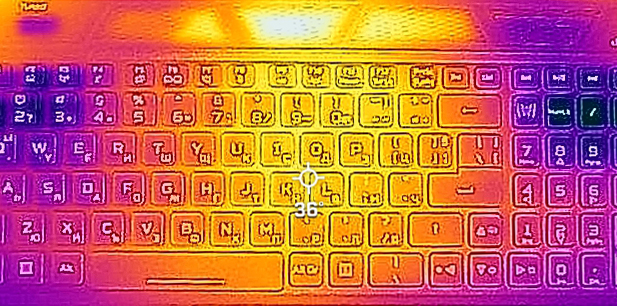
Verdict
 Ladies and gentlemen, if you’re wondering if this laptop has a MUX switch, you shouldn’t worry, because it has. It is hidden in the NVIDIA Control Panel, where you want to choose “NVIDIA GPU only” from the Optimus menu.
Ladies and gentlemen, if you’re wondering if this laptop has a MUX switch, you shouldn’t worry, because it has. It is hidden in the NVIDIA Control Panel, where you want to choose “NVIDIA GPU only” from the Optimus menu.
To be honest, this is a laptop that makes us feel grateful for the world we live in. It is not super expensive, and still comes absolutely packed with performance. The 150W RTX 3070 Ti slots right in between the 150W and 130W RTX 3080 in our “Top Laptop Graphics Ranking“.
Acer Predator Helios 300 (PH317-56)’s 17-inch display has an IPS panel with Quad HD resolution, a good contrast ratio, and comfortable viewing angles. It covers 99% of the DCI-P3 color gamut, which results in a vibrant image. Furthermore, our Gaming and Web design profile produces pretty accurate colors. You see, there is something that makes the panel really special. At this resolution, and 165Hz refresh rate, the secret ingredient is G-Sync. This means you get virtually no tearing, for an extremely smooth image. And this works pretty reliably as well.
As always, you are given some control over your device, thanks to the Predator Sense app. Frankly, the performance manipulation only includes some presets. This is nice, but it’s no way near the Armoury Crate of ASUS, which provides OC and power target options.
Yet again, we are in love with the simplicity of this notebook. It might look aggressive on the outside, but once you open the lid, you are met by a very balanced base design that simply looks good to the eye. Of course, you get a ton of obnoxious RGB – on the back of the lid, the bottom panel, and the keyboard – all controllable through the Predator Sense app.
It’s worth saying that the CPU of the Helios 300 (PH317-56) has received a liquid metal treatment, which makes a big impact on its thermals. It also uses DDR5 memory, while the storage comprises two M.2 PCIe x4 slots, which fit Gen 4 drives. As for the external ports, the only thing we are missing is the SD card reader. Other than that, even the LAN port is supercharged, as it supports 2.5G speeds.
So, if you are searching for a high-end gaming notebook, look no further. The Helios 300 will provide you with everything you need in terms of gaming experience.
You can check the prices and configurations in our Specs System: https://laptopmedia.com/series/acer-predator-helios-300-ph317-56/
Pros
- Thunderbolt 4 + HDMI + Mini DisplayPort
- Liquid metal and great cooling
- 2x SODIMM, 2x M.2 PCIe x4 Gen 4 slots
- 100% sRGB coverage and accurate color representation with our Gaming and Web design profile (BOE NE173QHM-NY6 (BOE0A1A))
- Quick pixel response times and G-Sync (BOE NE173QHM-NY6 (BOE0A1A))
- No PWM (BOE NE173QHM-NY6 (BOE0A1A))
- Outstanding performance
Cons
- Lacks an SD card reader
